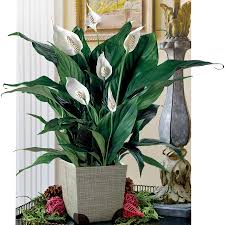The Ultimate Guide to Peace Lilies: Care, Types, and Troubleshooting
Peace lilies, scientifically known as Spathiphyllum, are ornamental houseplants known for their elegant and lush green foliage, as well as their stunning white blooms
6/3/20254 min read


Introduction to Peace Lilies
Peace lilies, scientifically known as Spathiphyllum, are ornamental houseplants known for their elegant and lush green foliage, as well as their stunning white blooms. Originating from the tropical rainforests of Central and South America, peace lilies thrive in warm, humid environments, making them well-suited for indoor cultivation. These plants can vary in size, typically reaching heights of 1 to 4 feet, with broad, dark green leaves that can grow up to 12 inches long, creating a visually striking appearance in any room.
The allure of peace lilies extends beyond their physical beauty; they are renowned for their air-purifying qualities. Research has shown that peace lilies can effectively remove toxins such as formaldehyde, benzene, and ammonia from the air, contributing to improved indoor air quality. This feature, combined with their low maintenance requirements, makes them a preferred choice among both novice and experienced plant enthusiasts.
Caring for Your Peace Lily
Caring for a peace lily (Spathiphyllum) involves understanding its specific needs to ensure its vibrancy and longevity. One of the primary considerations is light. Peace lilies thrive in bright, indirect sunlight, but they can also tolerate lower light conditions. However, placing them in direct sunlight may lead to leaf scorch, causing browning and damage. A well-lit spot, such as near a north or east-facing window, can help your peace lily flourish.
When it comes to soil, peace lilies prefer a well-draining potting mix, rich in organic matter. A combination of peat moss, perlite, and pine bark can create an ideal environment for their roots. It’s vital to use a pot with drainage holes to prevent water retention that can lead to root rot. This aspect of care cannot be overstated, as poor drainage is one of the most common issues that arise from improper soil choices.
Watering your peace lily requires a careful balance. It is best to allow the top inch of the soil to dry out between waterings. When the leaves begin to droop, it indicates the plant is thirsty, but try to avoid letting it dry out completely. Overwatering can cause yellowing leaves, emphasizing the importance of monitoring the moisture levels closely. During the growing season, weekly waterings are typically sufficient, while frequency may decrease in the dormant winter months.
Fertilization plays a significant role in the care of peace lilies. Using a balanced, water-soluble fertilizer every six to eight weeks during the growing season can support their growth and flower production. However, it is advisable to reduce or eliminate fertilization in winter months when the plant is not actively growing. By maintaining proper light conditions, soil that supports drainage, consistent watering practices, and thoughtful fertilization, peace lily enthusiasts can ensure their plants remain healthy and vibrant.
Common Issues: Why Is My Peace Lily Drooping?
Peace lilies are widely appreciated for their elegant blooms and ability to thrive in various indoor environments. However, drooping leaves can indicate distress and is a common problem among peace lily owners. Understanding the causes of drooping is essential for effective care and maintaining the health of your plant.
One of the primary reasons for drooping leaves is overwatering. When the roots sit in waterlogged soil, they can become deprived of oxygen, leading to root rot. This condition eventually results in leaves that droop as they struggle to receive adequate nutrients. To prevent this, ensure your peace lily is planted in well-draining soil and that the pot has proper drainage holes. Allow the top inch of soil to dry out before watering again, providing a balance that promotes healthy growth.
Conversely, underwatering can also cause leaves to droop. If the soil becomes too dry, the plant may not be able to absorb the necessary moisture, leading to wilting. To correct underwatering, water your peace lily thoroughly until excess water drains from the bottom. A consistent watering schedule is crucial in maintaining adequate moisture levels without risking over-saturation.
Pests can also play a role in the health of your peace lily. Spider mites, mealybugs, and aphids can weaken the plant, leading to drooping leaves. Regularly inspect the foliage for any signs of infestation. If pests are discovered, treat the plant with insecticidal soap or neem oil to eliminate the unwanted guests and restore vitality.
Environmental factors such as low humidity or extreme temperature fluctuations can further stress the plant, causing drooping. Peace lilies thrive in humidity levels of about 40-60%. To improve the environment, consider misting the leaves or placing a humidifier nearby. Monitoring temperature and avoiding drafty areas will also help keep your peace lily in optimal conditions.
Exploring Varieties: Japanese Peace Lily and Variegated Peace Lily
Within the realm of peace lilies, two notable varieties emerge, captivating the attention of plant enthusiasts: the Japanese peace lily and the variegated peace lily. Each of these variants possesses unique characteristics that distinguish them from the standard peace lily, making them appealing options for both seasoned gardeners and novices alike.
The Japanese peace lily, known scientifically as Spathiphyllum wallisii, is particularly celebrated for its striking dark green leaves and graceful white blooms. This variety is native to the tropical regions of Japan and tends to thrive in shaded environments, embodying the ideal specimen for indoor settings. The Japanese peace lily is less demanding in terms of light exposure compared to traditional varieties, making it suitable for homes with limited natural light. Its moderate growth rate and compact size allow it to fit seamlessly into various interior landscapes.
On the other hand, the variegated peace lily, or Spathiphyllum 'Domino', stands out due to its distinctive leaf coloration. Its foliage features striking white and green patterns that create an eye-catching appearance. This variety also produces white floral spathes, similar to other peace lilies, but its unique leaf patterns set it apart, enhancing its ornamental appeal. The variegated peace lily requires bright, indirect light to thrive and may need more attention regarding its watering schedule, as the variegation can indicate a slightly higher susceptibility to overwatering and light stress.
Both the Japanese and variegated peace lilies reflect the adaptability of the peace lily family. While they share fundamental care requirements such as moderate humidity and well-draining soil, their individual preferences can influence how they integrate into home environments. By understanding these differences, plant aficionados can make informed choices when selecting the right variety to complement their collection.
